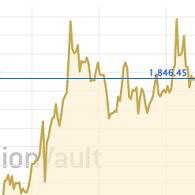Pricing gold in a glut currency
A dangerous bond glut
Pricing gold in a glut currency
I forget the figure exactly but there used to be a tip sheet doing the rounds which predicted gold at about $17,000 an ounce. I used to laugh at it, but now the more I look at it the more certain I am that the dollar is in an irredeemable mess. In fact gold might just go sailing through $17,000 an ounce without even gaining much value.
The reason is dollar bond issue. Twenty five years ago the world's dollar bond market was modest. After the high inflation decade of the seventies bonds were understood to be bad stores of value, and this was reflected in a much smaller demand for fixed interest securities from investors, and a much smaller supply from respectable borrowers. But since then several significant changes to the world financial scene have combined to accelerate the bond market through two decades of extraordinary growth.
Causes of bond market growth
Tax breaks : The first change was the widespread take up of government-approved and tax-generous savings schemes. Throughout the western world the consensus view grew that formalised saving for retirement was so beneficial that everyone should be encouraged by the tax system to do it. This had the effect of creating a wave of savings money looking for an investment home - not always very sensibly.
Inflation reporting : Another cause was the selectivity of inflation data. By concentrating on prices of manufactured retail goods at a time when technology was slashing their cost of production, and by eliminating from the statistics the asset-related costs of both retirement income and residential property, the impression was created that major currencies were not inflating, while in fact they have been - and seriously.
Consumer credit : Then there was liberalisation of access to consumer credit. I don't say this was a bad thing, but the reason credit used to be restricted was because it was so socially dangerous. Previous generations had found that natural debtors could not resist debt when it was freely offered, but that their use of it was potentially destabilising as it tended to create a gulf between rich and poor. At best separation into classes of debtors and creditors produced volatile business cycles and social injustice. At worst it triggered political upheaval and even revolution, which is one reason why it used to be so carefully controlled.
Deficit finance : A fourth change was that governments stopped worrying about balanced budgets and financed the shortage of their tax receipts by issuing bonds - elevated to AAA status by the prerogative of the state to create whatever money it might need to fund repayment. 'Reaganomics' was considered by many to be madness at the time, but Americans became used to the consumer benefits it gave them. Reagan's eight year administration ended having tripled the US public debt, with increases of about $200bn a year. Looked at now the Reagan Administration was positively thrifty, because the current deficit routinely increases at $500bn a year - or about $5,000 per US household annually.
Corporate executive incentives : There was also a widespread change in attitudes to management participation in corporate capital - through executive stock options. Previously these had been frowned upon and discouraged because they tended to encourage managers to shoot at personal exit targets which suited them, while causing longer term damage to shareholder security and the industrial base of the country. The new enthusiasm for these incentive schemes encouraged managers to gear company balance sheets by issuing bonds, and thereby multiply short term equity returns by exposing their organisations to larger long term debts.
Monetary stimulus : At the same time government intervention in the economy grew to be exceptionally reliable. With increasing certainty big business knew that a threat of economic recession would be met by a splurge of cheap central bank money - useful to them to pay their debts, and to their customers to buy more products. In fact because of falling rates for most of the last ten years a bond redemption has been a corporate bonus because steadily falling interest rates caused new bonds to be issued at lower rates than the ones they replaced.
Securitisation of mortgages : Household mortgages used to be financed out of the accumulated deposits of local savers. Now it is likely that a given individual mortgage has been packaged together with others and sold to an investment institution as what is known as a mortgage backed security. This releases cash to the mortgage company which can be lent to more borrowers. As a result household mortgages are in fact financed on the bond markets, and the providers of mortgages are among the biggest bond issuers on Earth.
Trade gaps : Last but not least the determination of Asian countries to build their industrial bases has been enabled by holding their currencies down against the dollar. The direct effect is an accumulation of dollars in Asia, received in payment for their exports not balanced by imports, and this surplus works its way to the local central bank and is used to buy the sovereign debts of the importer's country - frequently the USA. The unwillingness by the exporter's central bank to sell those dollars incurs a risk of a later dollar devaluation, but it benefits the exporter by holding their own currencies down and therefore allowing the continued construction of an export led industrial base, and a transfer eastwards of the technology and means of production. This of course is of no obvious benefit to the USA except that its electors can live beyond their means for a while, which may help to get incumbent democratic governments re-elected.
These changes - and others - have combined to produce a very big world market for fixed interest bonds. The supply of savings money and opposing supply of apparently reputable borrowers combined to grow a mighty industry by more than 50 times in 25 years.
The modern bondholder's dilemma
Throughout that time analysts have been scratching their heads about money supply statistics. These dull figures were once considered a useful indicator of future inflation. Yet although the various measures of money supply have consistently shown high increases, retail consumer price inflation has stayed low, held down by its technologically oriented statistical content.
What has happened instead is that twenty years of growing bond markets have steadily frozen the growing money supply into dollar denominated debt, spent by governments, corporate managements, and private consumers, and held as frozen spending power by foreign central banks and the world's investment companies in the form of bonds.
It is this accumulated world bond debt which hangs over us now. It is - in effect - waiting on any set of events, like those of the seventies, which might cause savers to turn away from assets destined for fixed future redemption in dollars. Bonds are the worst of investments in uncertain times, because they inflate to no value in loose monetary environments, or default to no value in tight monetary environments. Because of this they depend on widespread confidence in the ability of central bankers to walk the fine line which holds money values steady.
If the perception were to grow that money will not return its original purchasing power our bond overhang threatens a monster feedback which could cause dollars to be as oversupplied as German Marks in 1923. Bonds are periodically redeemed, and appear as cash whose owners decide if they want to invest in bonds again. If they say 'no' then dollars start to seep out from the bond market, and this could turn into a torrent.









 Email us
Email us